|
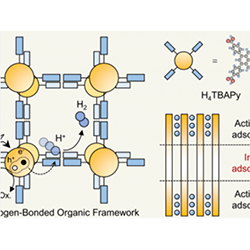
Organic semiconductors are an attractive class of photocatalysts for hydrogen production, but their quantum yield is limited by the transfer of photo-generated charges to the surface. Shortening the distance from the exciton coupling region to the catalyst surface is considered a promising strategy to reduce charge transfer losses. Professor Yongfa Zhu’s team at Tsinghua University used a one-dimensional hydrophilic micro-porous channel hydrogen-bonded organic framework HOF-H4TBAPy as a proof-of-concept for this method. Under irradiation, photo-generated excitons can rapidly transfer to the inner surface of adjacent micro-pores, forming a transfer path of only 1.88 nm, which significantly improves exciton utilization. When the length of the micro-pore channel is no more than 0.59 μm, the photocatalytic hydrogen production rate of HOF-H4TBAPy reaches 358 mmol h-1 g-1, and the apparent quantum yield at 420 nm is 28.6%. Professor Zhu’s team further demonstrated stable hydrogen production activity of 1.03 mol day-1 m-2 on a 0.5 m2 HOF-H4TBAPy-loaded fiber under 1 Sun irradiation.
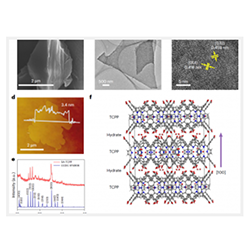
Hydrogen peroxide (H2O2) is an important industrial chemical and a potential energy carrier. Photocatalytic synthesis of H2O2 is an attractive alternative to the traditional anthraquinone process for producing H2O2, but the catalyst systems that have been explored so far have many problems, including limited sunlight wavelength response, the need to sacrifice reagents, and insufficient activity. Professor Yongfa Zhu’s team and others reported a self-assembled four (4-carboxyphenyl) porphyrin supramolecular photocatalyst that produces H2O2 from only H2O and O2, with quantum efficiencies of 14.9% and 1.1% at 420 nm and 940 nm, respectively. When simulated sunlight irradiation and heating were applied, the catalyst achieved a solar-to-chemical conversion efficiency of 1.2% at 328 K. The results show that photo-generated electrons and holes promote H2O2 production by reacting at different active sites such as the pyrrole N-H ring and carboxyl groups. In particular, this paper proposes a hole-induced H2O2 generation process, which involves the -COOH on the catalyst being converted to -CO3H under light, and then thermally decomposed. The related work, titled “H2O2 generation from O2 and H2O on a near-infrared absorbing porphyrin supramolecular photocatalyst,” was published in Nature Energy."
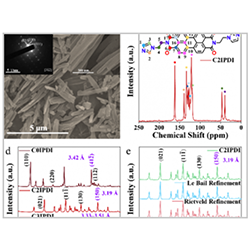
Tsinghua University Professor Yongfa Zhu’s team has developed a σ-linkage length modulation strategy to enhance carrier transport in D-σ-A type imidazole-alkyl-perylene diimide (IMZ-alkyl-PDI) photocatalysts by controlling the π-π stacking distance. In IMZ-alkyl-PDI (alkyl = none, ethyl and n-propyl), the ethyl bond can minimize the π-π stacking distance (3.19 ?) between D and A parts, thereby minimizing the spatial hindrance between them and achieving the fastest carrier transport rate. Based on this, the degradation ability of IMZ-ethyl-PDI for phenol is 32 times higher than that of IMZ-PDI, and the O2 evolution rate is 271 times higher. In a microchannel reactor, IMZ-ethyl-PDI also has an 81.5% phenol removal rate (44.73 L m-2 h-1).
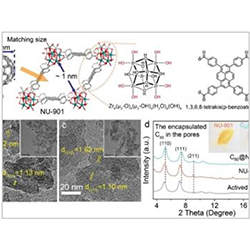
Metal-organic frameworks (MOFs) have attracted more attention and research in the field of photocatalysis due to their diverse topology, highly ordered and tunable pore structures, high specific surface area, widely distributed active sites, short photo-generated carrier diffusion distance, and good photo-thermal stability. However, MOFs photocatalytic materials have wide bandgap structures and high charge transfer resistance, which still face problems such as difficult photo-generated charge separation and low quantum efficiency in the field of photocatalysis. Professor Yongfa Zhu from Tsinghua University and Associate Professor Haibing Meng from Taiyuan University of Technology have embedded C60 into zirconium-based MOFs with pore size matching, constructing a novel host-guest MOFs photocatalyst. The material has a strong built-in electric field and highly ordered crystal structure, which promotes the separation and migration of photo-generated charges and achieves efficient photocatalytic hydrogen production. The related results were published in Angew. Chem. (DOI: 10.1002/anie.202217897).
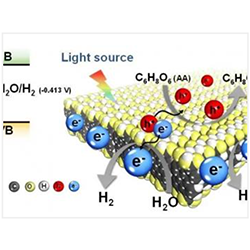
Harbin Institute of Technology’s School of Environment, in collaboration with Professor Yongfa Zhu’s team from the Department of Chemistry at Tsinghua University, has made significant progress in the field of clean energy research. The related results were published in the form of a research paper in Nature Communications, titled “Perylenetetracarboxylic Acid Nanosheets with Internal Electric Fields and Anisotropic Charge Migration for Photocatalytic Hydrogen Evolution”
|

